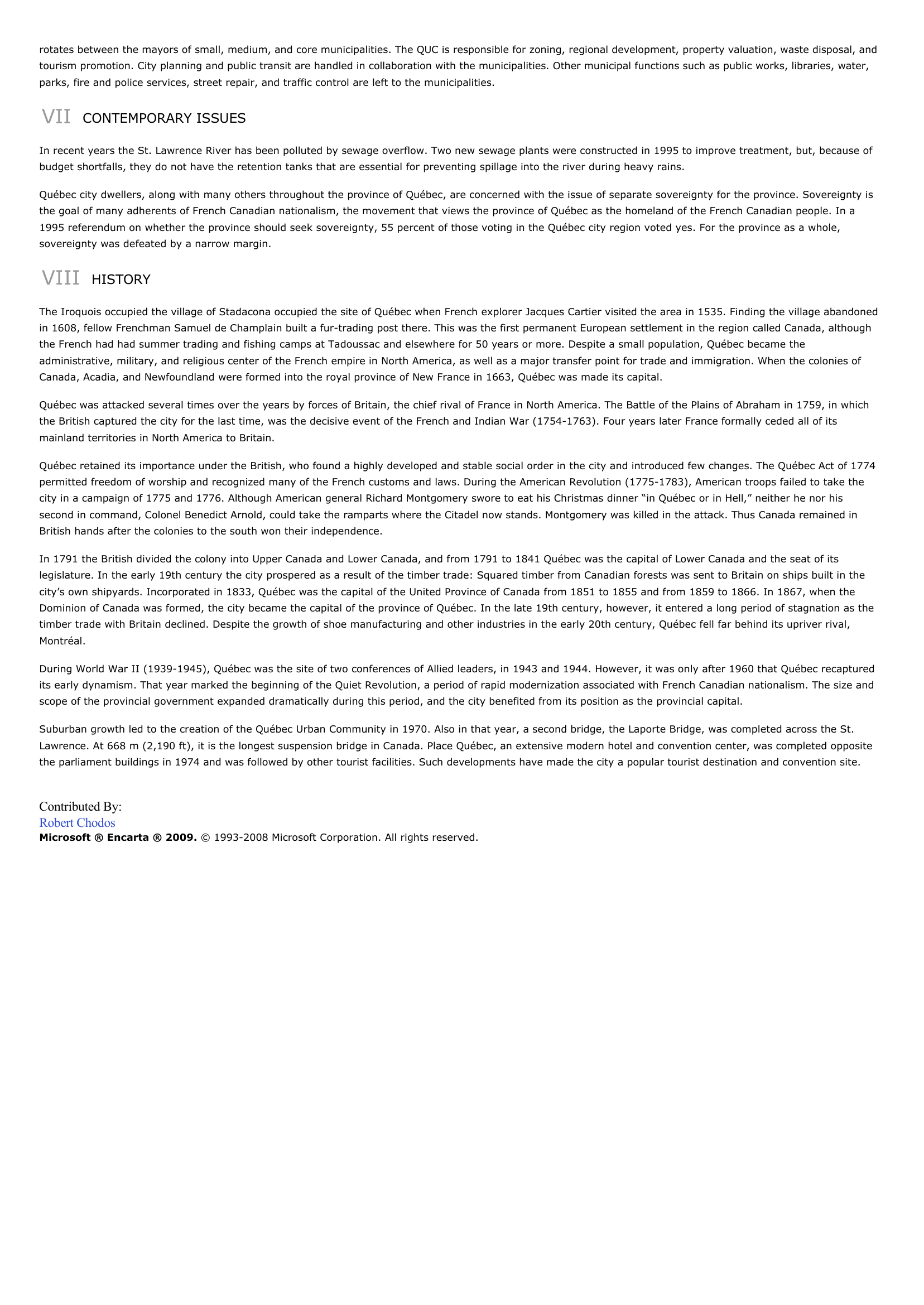Québec (city) - Geography.
Publié le 03/05/2013

Extrait du document
«
rotates between the mayors of small, medium, and core municipalities.
The QUC is responsible for zoning, regional development, property valuation, waste disposal, andtourism promotion.
City planning and public transit are handled in collaboration with the municipalities.
Other municipal functions such as public works, libraries, water,parks, fire and police services, street repair, and traffic control are left to the municipalities.
VII CONTEMPORARY ISSUES
In recent years the St.
Lawrence River has been polluted by sewage overflow.
Two new sewage plants were constructed in 1995 to improve treatment, but, because ofbudget shortfalls, they do not have the retention tanks that are essential for preventing spillage into the river during heavy rains.
Québec city dwellers, along with many others throughout the province of Québec, are concerned with the issue of separate sovereignty for the province.
Sovereignty isthe goal of many adherents of French Canadian nationalism, the movement that views the province of Québec as the homeland of the French Canadian people.
In a1995 referendum on whether the province should seek sovereignty, 55 percent of those voting in the Québec city region voted yes.
For the province as a whole,sovereignty was defeated by a narrow margin.
VIII HISTORY
The Iroquois occupied the village of Stadacona occupied the site of Québec when French explorer Jacques Cartier visited the area in 1535.
Finding the village abandonedin 1608, fellow Frenchman Samuel de Champlain built a fur-trading post there.
This was the first permanent European settlement in the region called Canada, althoughthe French had had summer trading and fishing camps at Tadoussac and elsewhere for 50 years or more.
Despite a small population, Québec became theadministrative, military, and religious center of the French empire in North America, as well as a major transfer point for trade and immigration.
When the colonies ofCanada, Acadia, and Newfoundland were formed into the royal province of New France in 1663, Québec was made its capital.
Québec was attacked several times over the years by forces of Britain, the chief rival of France in North America.
The Battle of the Plains of Abraham in 1759, in whichthe British captured the city for the last time, was the decisive event of the French and Indian War (1754-1763).
Four years later France formally ceded all of itsmainland territories in North America to Britain.
Québec retained its importance under the British, who found a highly developed and stable social order in the city and introduced few changes.
The Québec Act of 1774permitted freedom of worship and recognized many of the French customs and laws.
During the American Revolution (1775-1783), American troops failed to take thecity in a campaign of 1775 and 1776.
Although American general Richard Montgomery swore to eat his Christmas dinner “in Québec or in Hell,” neither he nor hissecond in command, Colonel Benedict Arnold, could take the ramparts where the Citadel now stands.
Montgomery was killed in the attack.
Thus Canada remained inBritish hands after the colonies to the south won their independence.
In 1791 the British divided the colony into Upper Canada and Lower Canada, and from 1791 to 1841 Québec was the capital of Lower Canada and the seat of itslegislature.
In the early 19th century the city prospered as a result of the timber trade: Squared timber from Canadian forests was sent to Britain on ships built in thecity’s own shipyards.
Incorporated in 1833, Québec was the capital of the United Province of Canada from 1851 to 1855 and from 1859 to 1866.
In 1867, when theDominion of Canada was formed, the city became the capital of the province of Québec.
In the late 19th century, however, it entered a long period of stagnation as thetimber trade with Britain declined.
Despite the growth of shoe manufacturing and other industries in the early 20th century, Québec fell far behind its upriver rival,Montréal.
During World War II (1939-1945), Québec was the site of two conferences of Allied leaders, in 1943 and 1944.
However, it was only after 1960 that Québec recapturedits early dynamism.
That year marked the beginning of the Quiet Revolution, a period of rapid modernization associated with French Canadian nationalism.
The size andscope of the provincial government expanded dramatically during this period, and the city benefited from its position as the provincial capital.
Suburban growth led to the creation of the Québec Urban Community in 1970.
Also in that year, a second bridge, the Laporte Bridge, was completed across the St.Lawrence.
At 668 m (2,190 ft), it is the longest suspension bridge in Canada.
Place Québec, an extensive modern hotel and convention center, was completed oppositethe parliament buildings in 1974 and was followed by other tourist facilities.
Such developments have made the city a popular tourist destination and convention site.
Contributed By:Robert ChodosMicrosoft ® Encarta ® 2009. © 1993-2008 Microsoft Corporation.
All rights reserved..
»
↓↓↓ APERÇU DU DOCUMENT ↓↓↓
Liens utiles
- Québec (city) - geography.
- Buenos Aires (city) - geography.
- Dublin (city, Ireland) - geography.
- Mexico City - geography.
- Moscow (city, Russia) - geography.


